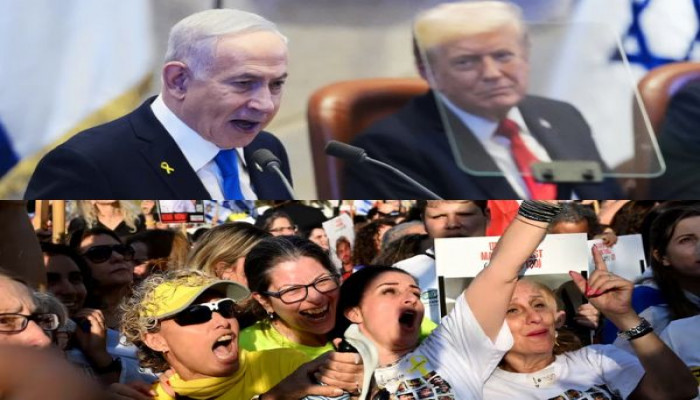Trump’s Gaza peace plan begins with hostage-prisoner exchange as world leaders gather for Sharm El Sheikh summit
- In Reports
- 08:25 PM, Oct 13, 2025
- Myind Staff
Hamas has started releasing Israeli and foreign hostages held in Gaza in exchange for Palestinian prisoners and detainees as part of the first phase of Donald Trump’s Gaza peace plan.
The agreement brought a ceasefire into effect last Friday and allowed more humanitarian aid to enter the Gaza Strip over the weekend.
Once the first phase is completed, further negotiations will take place to discuss the next stages of the plan.
The ceasefire deal that began on Friday requires Hamas to free all 48 Israeli and foreign hostages it still holds after two years of war, though only 20 are confirmed to be alive.
All but one of these hostages were among the 251 people kidnapped during the group’s attack on southern Israel on 7 October 2023, when around 1,200 people were killed. Israel launched a military campaign in response that has killed more than 67,000 people, according to Gaza’s Hamas-run health ministry.
On Monday morning, Hamas handed over 20 living hostages to the International Committee of the Red Cross in two groups.
Israeli authorities identified the first group as Eitan Mor, Gali Berman, Ziv Berman, Omri Miran, Alon Ohel, Guy Gilboa-Dalal, and Matan Angrest.
The second group included Bar Kupershtein, Evyatar David, Yosef-Chaim Ohana, Segev Kalfon, Avinatan Or, Elkana Bohbot, Maxim Herkin, Nimrod Cohen, Matan Zangauker, David Cunio, Eitan Horn, Rom Braslabski, and Ariel Cunio.
A copy of the ceasefire agreement released by Israeli media stated that the remains of all deceased hostages must also be handed over by 12:00 local time on Monday, though it noted that Hamas and other Palestinian groups might not be able to locate all of them within that time.
An Israeli official said an international task force would begin working to locate the remains of any hostages who were not returned.
In return, Israel agreed to release 250 Palestinian prisoners serving life sentences and 1,718 detainees from Gaza, including 15 minors.
The Hamas-run Prisoners Media Office published updated lists of the detainees and prisoners on Monday morning.
The list did not include any high-profile figures serving multiple life sentences for deadly attacks on Israelis, such as Marwan Barghouti and Ahmad Saadat, whose release Hamas had demanded.
Israeli media reported that around 100 of the 250 prisoners would be released into the occupied West Bank, 15 to East Jerusalem, and 135 would be deported to Gaza or other locations.
It remains unclear whether delays in the return of deceased hostages could affect the release of Palestinian prisoners.
The ceasefire began in Gaza at 12:00 local time on Friday.
Over the weekend, larger amounts of aid entered the territory.
The Israeli military confirmed its troops had withdrawn to a line outlined in the agreement, which keeps it in control of 53 percent of Gaza, according to a spokesperson from the prime minister’s office.
A map released by the White House last week showed this as the first of three stages of Israeli withdrawal, with later stages planned under Trump’s peace plan.
A multinational force of about 200 troops under US military supervision is monitoring the ceasefire, a senior US official said.
The force includes personnel from Egypt, Qatar, Turkey, and the United Arab Emirates.
The official said its role is to observe the ceasefire and ensure there are no violations or incursions. Another senior official confirmed that no US troops are deployed on the ground in Gaza.
If the exchange of hostages and prisoners is completed successfully, further negotiations will follow over the remaining phases of Trump’s 20-point plan.
The plan states that if both sides agree, the war would “immediately end”.
It also says Gaza would be demilitarised and all “military, terror and offensive infrastructure” destroyed.
According to the plan, Gaza would first be governed by a temporary transitional committee of Palestinian technocrats under the supervision of a “Board of Peace” chaired by Trump and including former UK Prime Minister Tony Blair.
The Palestinian Authority would later assume control of Gaza after completing the required reforms.
Hamas, which has ruled Gaza since 2007, would have no role in its future administration.
Members of Hamas would be offered amnesty if they accepted peaceful coexistence or given safe passage to another country.
No Palestinians would be forced to leave Gaza, and those who wished to go would be allowed to return.
A “Trump economic development plan to rebuild and energise Gaza” would be launched by a group of experts.
Several points of disagreement are expected during later negotiations.
Hamas has previously refused to disarm unless a Palestinian state is established.
The group made no mention of disarmament in its initial response to the plan last weekend, suggesting its position remains unchanged.
While Israel accepted Trump’s plan in full, Prime Minister Benjamin Netanyahu opposed giving the Palestinian Authority a role in post-war Gaza, even as he stood beside its president last week.
Hamas also said it expects to play a future role in Gaza as part of “a unified Palestinian movement”.
Another key issue is the scope of Israeli troop withdrawal. Israel said its first withdrawal leaves it controlling about 53 per cent of Gaza.
The White House plan shows further withdrawals, reducing that control to 40 per cent and then 15 per cent.
The final stage would establish a “security perimeter” that would “remain until Gaza is properly secure from any resurgent terror threat”.
The language remains vague and does not specify a timeline for full Israeli withdrawal, which Hamas is expected to demand.
Meanwhile, Donald Trump and Egyptian President Abdel Fattah al-Sisi will co-host a summit of more than 20 world leaders in Sharm El Sheikh on Monday, after Trump visits Israel to address the Knesset and meet families of hostages.
The summit aims “to end the war in the Gaza Strip, enhance efforts to achieve peace and stability in the Middle East, and usher in a new era of regional security and stability”, according to the Egyptian presidency.
The US president will seek to advance his peace efforts, with unresolved issues including Gaza’s future governance and the fate of Hamas. He told reporters on Sunday that “the war is over”.
Egypt has played a leading role in negotiations between Israel and Hamas throughout the conflict. Al-Sisi’s invitation for Trump to take a “victory lap” of the region was aimed at ensuring the ceasefire holds, a source told Reuters.
Qatar’s Emir Sheikh Tamim bin Hamad Al Thani was among the Arab leaders who urged Trump to remain tied to the peace process, believing his involvement would help guarantee its success.
Trump’s plan leaves room for a possible role for Mahmoud Abbas’s Palestinian Authority in Gaza, depending on certain reforms, though Netanyahu has opposed the idea.
The summit will also be attended by French President Emmanuel Macron, Turkish President Recep Tayyip Erdoğan, UK Prime Minister Keir Starmer, Spanish Prime Minister Pedro Sánchez, Italian Prime Minister Giorgia Meloni, European Council President Antonio Costa, UN Secretary-General António Guterres, and Arab League Secretary-General Ahmed Aboul Gheit.
Israel will not send a representative to the summit, according to a spokesperson for Prime Minister Benjamin Netanyahu.
A Hamas official said the group “will not be involved”, adding that it had relied on Qatari and Egyptian mediators during previous talks.
Iran confirmed that neither its President, Masoud Pezeshkian, nor Foreign Minister Abbas Araghchi would attend, despite receiving an invitation.







Comments